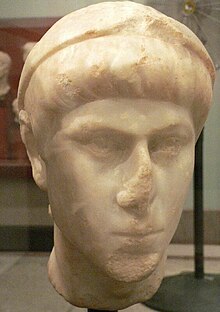Agilo (army master)
Agilo was a high-ranking Roman military from late antiquity . Under the emperors Constantius II. And Julian , he held one of the highest military offices in the middle of the 4th century AD as a master of the army ( magister militum ) .
Life
Agilo was a native of Alamanne . It is not known when he was accepted into the Roman army . In any case, in 354 he was already serving in a relatively high function, as Tribunus stabuli ( tribune of the imperial stable) in a campaign by Constantius against the Alemanni on the Rhine border. Here he came under suspicion - probably due to his origin - together with Latinus and Scudilo of having betrayed important war secrets to the Alamanni. His high reputation apparently saved him from further allegations. After that he does not appear again until 359 in the sources, this time in the function of a Tribunus gentilium et scutariorum (Tribune of the Gentiles and Scutarii ). As the successor to Ursicinus , he was appointed army master of the infantry (magister peditum) in the same year , an unusual career leap that Agilo owed to Constantius's special appreciation.
In this function he secured the eastern border of the empire against the Persian Sassanids together with his colleague in the army master's office, Arbitio . The generals initially assessed the situation as dangerous and asked for reinforcements, but eventually the Persian King Shapur II withdrew, whereupon the Roman troops were withdrawn from the border. At the same time, the previous Caesar (lower emperor) Julian was proclaimed Augustus in the west of the empire . An understanding with Constantius about the division of power and imperial titles had failed; a civil war was threatened. In this situation, Constantius sent Agilo and Arbitio with their troops to the west. The civil war was averted by the fact that Constantius II died unexpectedly on November 3, 361 of an illness.
Agilo, who almost fought Julian just now, quickly switched sides after Constantius' death. Julian, the new sole ruler, knew how to use this: The city of Aquileia considered the news of Constantius' death to be a trick by Julian and continued to be loyal to the dead emperor, so Julian sent the respected general Agilo there. The siege could only be ended when he affirmed under oath that Constantius was actually dead. Only then were the gates opened and the alleged instigators of the resistance extradited. Julian then appointed Agilo one of the judges in the trials that were brought against alleged opponents of the new emperor in Chalcedon . Agilo was jointly responsible for the execution and banishment of numerous former dignitaries of Constantius, including not only unpopular courtiers like the chamberlain Eusebius or the brutal notary Paulus "the chain" , but also high officials whose condemnation was controversial. Soon afterwards - probably 362 - he retired. His successor in the army master's office was Victor .
Julian died in 363 on a Persian campaign. Two years later, his relative Procopius , who relied on his connection to the Constantinian dynasty , which was replaced after Julian's death, proclaimed himself emperor. The usurper managed to get Agilo, the former army master of his relatives, together with his former colleague Gomoarius to his side. They were reappointed army masters. He used the high reputation that Agilo apparently enjoyed under Procopius, among other things, to finally establish a Praetorian prefecture for Araxius , the father of his wife, a former friend of Emperor Julian's and the orator Libanios , who had already held high positions in the 350s to help. In the civil war against the legitimate Emperor Valens , however, Agilo betrayed Procopius in 366 by deferring to Valens with his troops. With this he sealed the downfall of Procopius, who lost the Battle of Thyatira , was captured after a failed escape near Nakoleia and beheaded without further delay. Agilo was then apparently rehabilitated. His father-in-law Araxius, on the other hand, was arrested for participating in the uprising, but instead of being executed at Agilo's intercession, he was banished to an island.
Nothing is known about Agilo's further activities and his death.
literature
- Arnold Hugh Martin Jones , John Robert Martindale, John Morris : Agilo. In: The Prosopography of the Later Roman Empire (PLRE). Volume 1, Cambridge University Press, Cambridge 1971, ISBN 0-521-07233-6 , pp. 28-29.
- Otto Seeck : Agilo . In: Paulys Realencyclopadie der classischen Antiquity Science (RE). Volume I, 1, Stuttgart 1893, Col. 809.
Remarks
- ↑ Ammianus Marcellinus 14,10,8.
- ↑ Ammian 20,2,5.
- ↑ Ammian 21,13,3. For the centuries-old rivalry between the two great empires, see Roman-Persian Wars .
- ↑ Ammian 21,13,5.
- ↑ Ammian 21,13,8.
- ↑ Ammian 21,12,16; 21,12,18; see. also 22,8,49.
- ↑ On the processes in Chalcedony with critical evaluation Ammian 22.3, on Agilo's involvement Ammian 22.3.1.
- ↑ Ammian 26,7,4.
- ↑ Ammian 26,7,6.
- ↑ Ammian 16, 9, 7-9. Also Zosimos 4,8,3; Philostorgios 9.5. Socrates Scholastikos 4,5 and Sozomenos 6,8,2 wrongly state that Agilo was executed.
- ↑ Ammian 26,10,7.
| personal data | |
|---|---|
| SURNAME | Agilo |
| BRIEF DESCRIPTION | roman military |
| DATE OF BIRTH | 3rd century or 4th century |
| DATE OF DEATH | after 366 |
